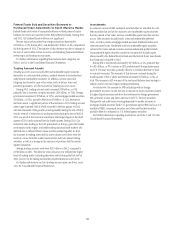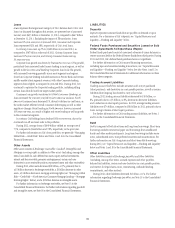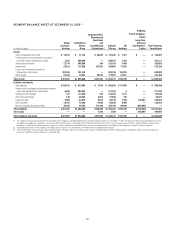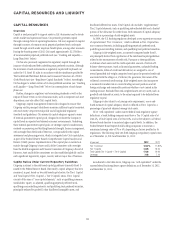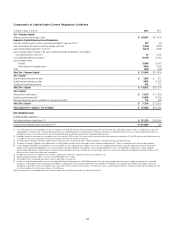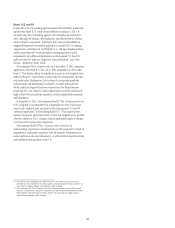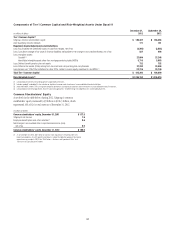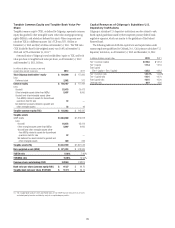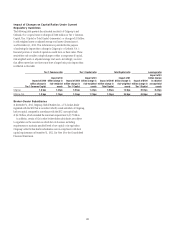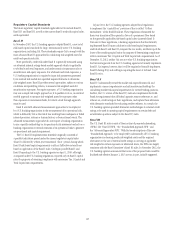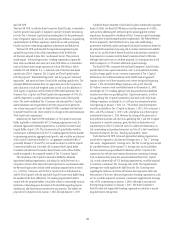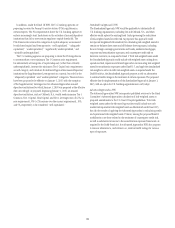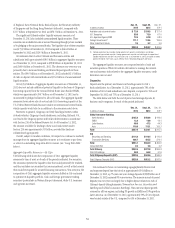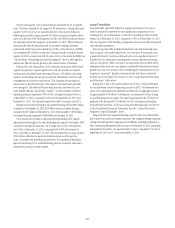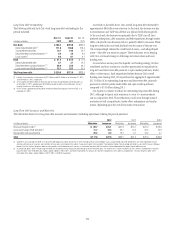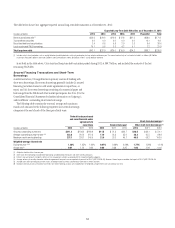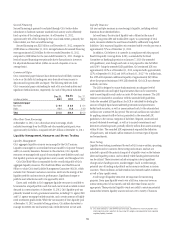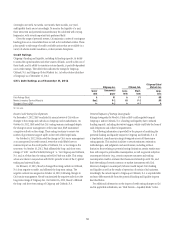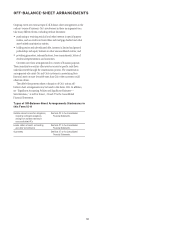Citibank 2012 Annual Report Download - page 70
Download and view the complete annual report
Please find page 70 of the 2012 Citibank annual report below. You can navigate through the pages in the report by either clicking on the pages listed below, or by using the keyword search tool below to find specific information within the annual report.48
Basel III NPR
The Basel III NPR, as with the Basel Committee Basel III rules, is intended to
raise the quantity and quality of regulatory capital by formally introducing
not only Tier 1 Common Capital and mandating that it be the predominant
form of regulatory capital, but by also narrowing the definition of qualifying
capital elements at all three regulatory capital tiers as well as imposing
broader and more constraining regulatory adjustments and deductions.
The Basel III NPR would modify the regulations implementing the
capital floor provision of the Collins Amendment of the Dodd-Frank
Act that were adopted in June 2011 (as discussed above). This provision
would require “Advanced Approaches” banking organizations (generally
those with consolidated total assets of at least $250 billion or consolidated
total on-balance sheet foreign exposures of at least $10 billion), which
includes Citi and Citibank, N.A., to calculate each of the three risk-based
capital ratios (Tier 1 Common, Tier 1 Capital and Total Capital) under
both the proposed “Standardized Approach” and the proposed “Advanced
Approaches” and report the lower of each of the resulting capital ratios. The
principal differences between these two approaches are in the composition
and calculation of total risk-weighted assets, as well as in the definition of
Total Capital. Compliance with the Basel III NPR stated minimum Tier 1
Common, Tier 1 Capital, and Total Capital ratio requirements of 4.5%, 6%,
and 8%, respectively, would be assessed based upon each of the reported
ratios. The newly established Tier 1 Common and increased Tier 1 Capital
stated minimum ratio requirements have been proposed to be phased in
over a three-year period. Under the Basel III NPR, consistent with the Basel
Committee Basel III rules, there would be no change in the stated minimum
Total Capital ratio requirement.
Additionally, the Basel III NPR establishes a 2.5% Capital Conservation
Buffer applicable to substantially all U.S. banking organizations and, for
Advanced Approaches banking organizations, a potential Countercyclical
Capital Buffer of up to 2.5%. The Countercyclical Capital Buffer would be
invoked upon a determination by the U.S. banking agencies that the market
is experiencing excessive aggregate credit growth, and would be an extension
of the Capital Conservation Buffer (i.e., an aggregate combined buffer of
potentially between 2.5% and 5%). Citi would be subject to both the Capital
Conservation Buffer and, if invoked, the Countercyclical Capital Buffer.
Consistent with the Basel Committee Basel III rules, both of these buffers
would be required to be comprised entirely of Tier 1 Common Capital.
The calculation of the Capital Conservation Buffer for Advanced
Approaches banking organizations, including Citi, would be based on a
comparison of each of the three risk-based capital ratios as calculated under
the Advanced Approaches and the stated minimum required ratios for each
(i.e., 4.5% Tier 1 Common and 6% Tier 1 Capital, both as fully phased-in,
and 8% Total Capital), with the reportable Capital Conservation Buffer being
the smallest of the three differences. If a banking organization failed to
comply with the proposed buffers, it would be subject to increasingly onerous
restrictions (depending upon the extent of the shortfall) regarding capital
distributions and discretionary executive bonus payments. The buffers are
proposed to be phased in from January 1, 2016 through January 1, 2019.
Unlike the Basel Committee’s final rules for global systemically important
banks (G-SIBs), the Basel III NPR does not include measures for G-SIBs,
such as those addressing the methodology for assessing global systemic
importance, the imposition of additional Tier 1 Common capital surcharges,
and the phase-in period regarding these requirements. The Federal Reserve
Board is required by the Dodd-Frank Act to issue rules establishing a
quantitative risk-based capital surcharge for financial institutions deemed to
be systemically important and posing risk to market-wide financial stability,
such as Citi, and the Federal Reserve Board has indicated that it intends for
these rules to be consistent with the Basel Committee’s final G-SIB rules.
Although these rules have not yet been proposed, Citi anticipates that it will
likely be subject to a 2.5% initial additional capital surcharge.
The Basel III NPR, consistent with the Basel Committee’s Basel III rules,
provides that certain capital instruments, such as trust preferred securities,
would no longer qualify as non-common components of Tier 1 Capital.
Furthermore, the Collins Amendment of the Dodd-Frank Act generally
requires a phase-out of these securities over a three-year period beginning
January 1, 2013 for bank holding companies, such as Citi, that had
$15 billion or more in total consolidated assets as of December 31, 2009.
Accordingly, the U.S. banking agencies have proposed that trust preferred
securities and other non-qualifying Tier 1 Capital instruments, as well as
non-qualifying Tier 2 Capital instruments, be phased out by these bank
holding companies, including Citi, at a 25% per year incremental phase-
out beginning on January 1, 2013 (i.e., 75% of these capital instruments
would be includable in Tier 1 Capital on January 1, 2013, 50% on January 1,
2014, and 25% on January 1, 2015), with a full phase-out of these capital
instruments by January 1, 2016. However, the timing of the phase-out of
trust preferred securities and other non-qualifying Tier 1 and Tier 2 Capital
instruments is currently uncertain, given the delay in finalization and
implementation of the U.S. Basel III rules. For additional information on
Citi’s outstanding trust preferred securities, see Note 19 to the Consolidated
Financial Statements. See also “Funding and Liquidity” below.
Under the Basel III NPR, Advanced Approaches banking organizations
would also be required to calculate two leverage ratios, a “Tier 1” Leverage
ratio and a “Supplementary” Leverage ratio. The Tier 1 Leverage ratio would
be a modified version of the current U.S. leverage ratio and would reflect
the more restrictive proposed Basel III definition of Tier 1 Capital in the
numerator, but with the same current denominator consisting of average
total on-balance sheet assets less amounts deducted from Tier 1 Capital.
Citi, as with substantially all U.S. banking organizations, would be required
to maintain a minimum Tier 1 Leverage ratio of 4%. The Supplementary
Leverage ratio would significantly differ from the Tier 1 Leverage ratio
regarding the inclusion of certain off-balance sheet exposures within the
denominator of the ratio. Advanced Approaches banking organizations, such
as Citi, would be required to maintain a minimum Supplementary Leverage
ratio of 3%, commencing on January 1, 2018, although it was proposed
that reporting commence on January 1, 2015. The Basel Committee’s
Basel III rules only require that banking organizations calculate a similar
Supplementary Leverage ratio.


